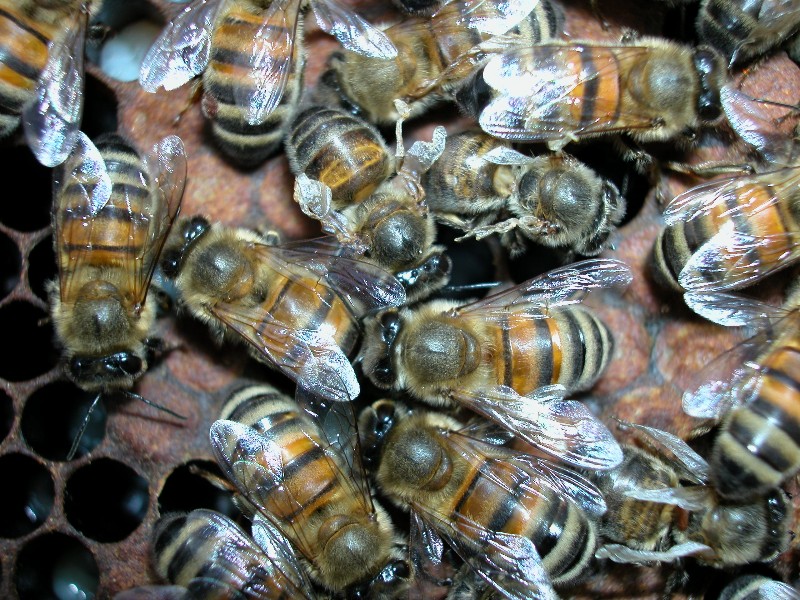Honeybee Diseases - Deformed wing Virus
Deformed Wing Virus (DWV) is a disease caused by one the Ifluvinidae insect infecting viruses which is closely associated with Varroa destructor and colony loss. Its name comes from the deformed wings and underdeveloped abdomens on emerging adult bees which is the most obvious signs of its presence in the colony however there are often other less obvious deformities present in developing pupae and emerged adults. Infected bees can not perform normal functions and die soon after emergence and are removed from the nest. The virus also is also known to infect other bee species such as Bumblebees (Bombus spp.)
Varroa destructor is known to carry and transmit significantly high levels of DWV and untreated together they are likely cause colony loss. Much about DWV is as yet unknown however ongoing research into Varroa and DWF continues and has revealed that the virus may cause immune system suppression in bees, affect bee sensory systems, bee colouration, and cause damaged and paralysed limbs. It is also suspected that V. destructor acts as a carrier, delivers concentrated amounts of DWV, and may also be an effective incubator of the virus. DWV can also persist in colonies without V. destructor present, and is passed around the colony through normal feeding activities.
Download the DWV Info Sheet, the Varroa Info Sheet and the Integrated Pest Management plan to obtain a printable versions of DWV and Varroa information, detection and treatment methods for your records.
Recognition
Image Courtesy The Animal and Plant Health Agency (APHA), © Crown Copyright

Deformed wings clearly visible on adult bees. Easily seen in the hive.
As previously described infected bees can be clearly seen during normal hive manipulations. Key indicators are deformed / shrunken wings and abdomen, paralised / damaged / deformed limbs.
Life Cycle - Little is know presently about Ifluvinidae viruses that affect insects including honeybees, however it is known to exist at low levels in healthy colonies of honeybees with healthy immune systems without apparent effect. Where V. destructor is present it is known to exist at far higher concentrations that colonies struggle to deal with on their own, and untreated eventually collapse.
Detection
Hive Examination - Due to the conspicuous nature of DWV deformities, examination of bees during normal hive inspections will reveal its presence. Bees with deformities indicate a high level of DWV infection in the hive that the bees immune systems are not coping with, it is also an indication of a high level of Varroa infestation.
Monitoring - As with all honeybee related diseases vigilance is important. Regular, careful and thorough inspections will reveal levels of DWV and associated V. destructor levels in the hive.
Treatment
Apis mellifera may be able to cope with low levels of covert DWV in a colony of healthy unstressed honeybees however where V. desrtuctor is present and there are visible signs of DWV deformities treatment should be carried out without delay. Treating for V. desrtuctor will reduce the levels of infestation and associated stress on the colony and will suppress the levels of DWV. Left untreated, colonies of bees will eventually die. Please download the Varroa Info Sheet and the Integrated Pest Management plan to obtain a printable version of Varroa information, detection and treatment methods
Vectors
Varroa mites cling on to and travel with adult bees wherever they go, and move from hive to hive, transferring to other bees and colonies.
- Robbing - When a colony is severely affected it becomes a target for robbers. Not only do they take any stores but also pick up large numbers of mites.
- Drifting - Poor apiary design and location will allow young bees to drift into neighbouring colonies. This is particularly important with drones as are they are accepted into any colony.
- Bee Migration - Bees from collapsing colonies abscond from their own hive with the robbers and increase the mite load in the robbers hive.
- Migratory Beekeeping - Moving colonies around the countryside to exploit nectar flows such as heather moors and seasonal OSR has great potential to rapidly spread all diseases. Colony health should be checked before deciding if it is safe to move them.
- Swarming - A swarm from an infested colony will always carry mites with it. It is essential to test any swarm for the mite and treat it before introducing it to the apiary.
- Feral Swarms - Swarms from feral colonies are no more likely to be free than those from managed colonies but can spread the mite naturally by 3-5km per year.
- Beekeepers - Careless manipulative management by the beekeeper can transfer affected bees to other colonies in the apiary and to other apiaries. Migratory beekeeping can cause a rapid spread throughout a country.
Try the Honeybee Diseases Quiz
About the 'My Beekeeping Kit' website.
Contact Iain Dewar for enquiries, suggestions, corrections and contributions for improving the notes. Always welcome!